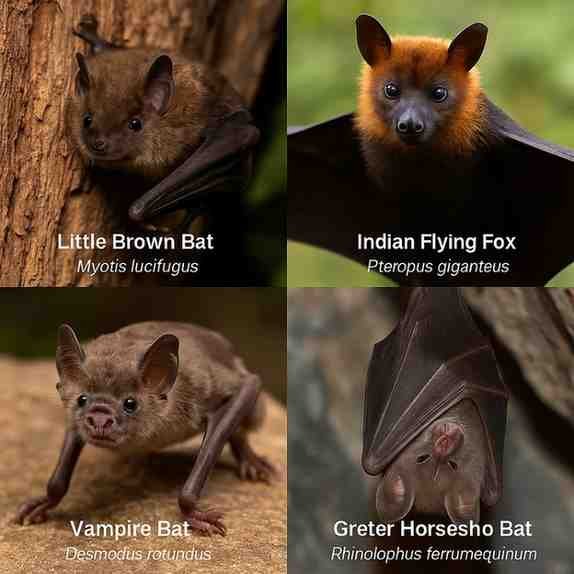What is the scientific name for bats? The bat scientific name is Chiroptera.
Bats are one of the most magnificent mammals on Earth, with over 1,400 species worldwide. These well-known creatures are among the only mammals that can perform true flight and are important for their role in pollination, seed dispersal, and pest control. This article will take you on a deep dive into the scientific names of bats, including their meanings, pronunciation, genus, biological classification, and types of bats with scientific names. Also, learn more about the vampire bat scientific name, the common bat’s scientific name, among others.
Table of Contents
What is the Scientific Name for Bats?
The general scientific name for a bat is based on the order Chiroptera.
Pronunciation and Meaning of Bats Scientific Name
- Chiroptera is pronounced: ky-rop-teh-rah
- Meaning: Derived from Greek – cheir meaning “hand” and pteron meaning “wing.”
This describes the structure of bat wings, which consist of a thin membrane extending between long fingers.
Complete Bats Classification (Taxonomy)
All bats fall under the same taxonomic order, but vary at the level of family, genus, and species.
Biological Classification of Bats
| Level | Classification |
|---|---|
| Kingdom | Animalia |
| Phylum | Chordata |
| Class | Mammalia |
| Order | Chiroptera |
| Suborders | Megachiroptera, Microchiroptera |
| Number of Families | Over 20 |
| Number of Species | Over 1,400 |
Suborders of Bats
- Megachiroptera: Large fruit bats (e.g., flying foxes) that rely on sight and smell.
- Microchiroptera: Small bats that use echolocation to hunt insects and navigate.
Common Bat Scientific Name
The Little Brown Bat, which is found all over North America, is one of the most popular species.
Biological Details of the Common Bats
- Scientific Name: Myotis lucifugus
- Genus: Myotis
- Family: Vespertilionidae
- Habitat: Forests, cities, caves, and buildings
Myotis bats are insectivorous and serve as beneficial pest control. They are one of the most common types found in cities.
Vampire Bat Scientific Name
It is a mere myth and contrary to truth that vampire bats are small, nonaggressive blood-sucking beings that suck blood from animals rather than humans.
Biological Details of Vampire Bats
- Scientific Name: Desmodus rotundus
- Genus: Desmodus
- Subfamily: Desmodontinae
- Family: Phyllostomidae
- Habitat: Central and South America
These bats are famous for having well-adapted heat sensors and teeth so sharp they can make painless incisions to feed on animals’ skins.
Types of Bats and Their Scientific Names

There are thousands of species of bats. Below are examples of scientific names for different categories of bats.
| Common Name | Scientific Name | Type |
|---|---|---|
| Big Brown Bat | Eptesicus fuscus | Insectivore |
| Hoary Bat | Lasiurus cinereus | Insectivore |
| Indian Flying Fox | Pteropus giganteus | Frugivore |
| Egyptian Fruit Bat | Rousettus aegyptiacus | Frugivore |
| Greater Horseshoe Bat | Rhinolophus ferrumequinum | Insectivore |
| Common Pipistrelle | Pipistrellus pipistrellus | Insectivore |
Each bat species has a unique ecological role, from eating insects and pollinating flowers to spreading seeds in forests.
How Bat Species Differ: Types, Diets, and Habitats
Bats can vary in many things, from their natural physiology to their diet, anatomy, and behavior, in addition to their habitat.
Based on Diet
- Insectivorous Bat: This bat consumes mosquitoes, beetles, and moths, such as Myotis lucifugus.
- Fruit-eating bats: These bats eat fruit and are also seed dispersers, such as Pteropus giganteus, which eats fruit.
- Nectar-feeders: These consume nectar as their food and may pollinate flowers, such as Glossophaga soricina.
- Carnivorous bat: These types of bats eat small animals, which are usually small vertebrates, including frogs and mice. An example is Phyllostomus hastatus.
- Hematophagous: Some bats rely entirely on blood as their diet, such as Desmodus rotundus.
Based on Geographic Distribution
- North American species: Myotis lucifugus, Eptesicus fuscus
- African species: Rousettus aegyptiacus
- Asian species: Pteropus giganteus
- South American species: Desmodus rotundus
Importance of Scientific Naming in Bats
These names eliminate confusion due to the many common local names; for example, Myotis lucifugus or Desmodus rotundus. As a result, it can offer:
- Universal Identification
- Evolutionary Relationships
- Conservation Efforts
- Better Scientific Communication Worldwide
Summary: Bat Scientific Names and Classification
To sum it all up:
- Order of Bats: Chiroptera
- Common scientific name for bats: Myotis lucifugus
- Scientific name for vampire bats: Desmodus rotundus
- Total species: Over 1,400 worldwide
- Suborders: Megachiroptera and Microchiroptera
- Dietary types: Insectivorous, frugivorous, nectarivorous, carnivorous, and bloodsuckers
Bats are ecologically essential mammals with a complex taxonomic system. From pest control to pollination, their contribution to biodiversity is immeasurable.
Related article
- Want to know about other interesting animals and their classification details?

